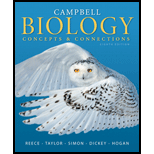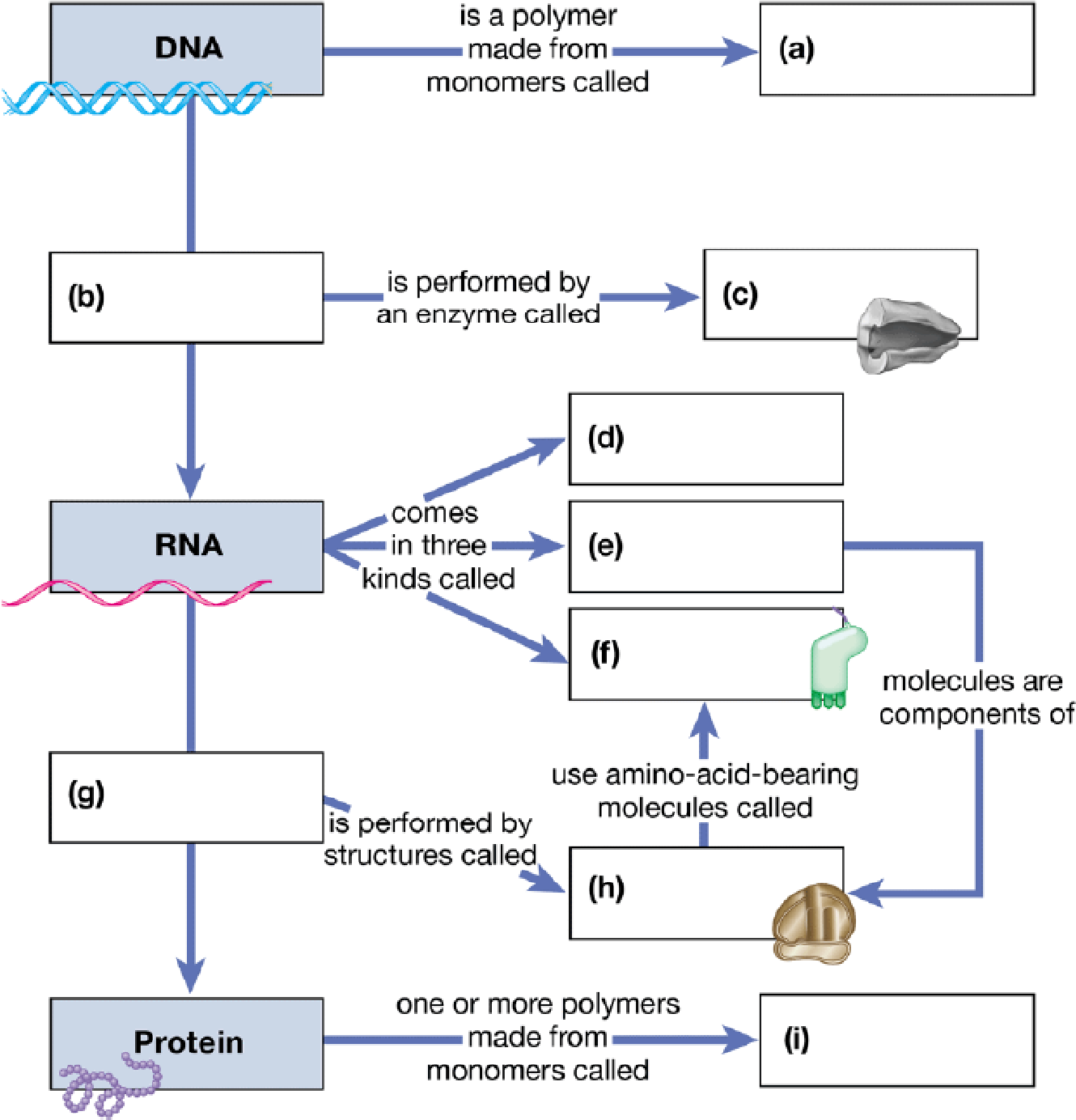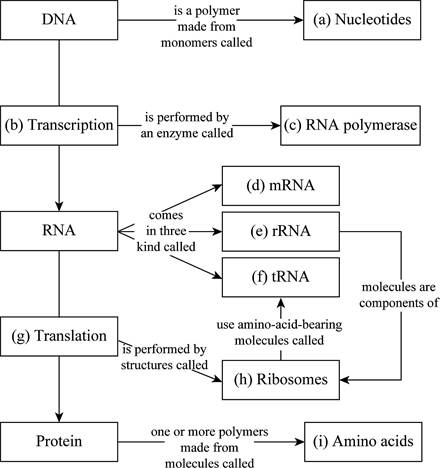
Concept explainers
Check your understanding of the flow of genetic information through a cell by filling in the blanks.

To complete: The given map showing the flow of genetic information through a cell.
Introduction: DNA is the blueprint of life. The genetic information of DNA is based in the nucleotide base sequences. These sequences are transcribed into mRNA triplets. These triplets of nucleotides are known as codons and they form the genetic code. They code for specific amino acids for the synthesis of proteins is known as functional gene products. This is known as gene expression.
Answer to Problem 1CC
Pictorial representation: Fig. 1 shows the completed map of flow of genetic information through a cell.

Fig.1 Flow of genetic information through a cell
Explanation of Solution
(a)
Correct answer: Nucleotides.
Explanation: The nucleotides are the building blocks of nucleic acids (DNA and RNA). DNA is a polymer made up of nucleotide monomers (adenine, thymine, cytosine, and guanine) and also known as polynucleotide. Hence, the correct answer is nucleotides.
(b)
Correct answer: Transcription.
Explanation: DNA consists of genetic instructions in the form of nucleotide sequences. It acts as a template and directs the messenger RNA (mRNA) synthesis in the cell. The process of formation of mRNA is known as transcription. Hence, the correct answer is transcription.
(c)
Correct answer: RNA polymerase.
Explanation: RNA polymerase enzymes are of three types out of which, RNA pol II transcribes mRNA. RNA pol II enzyme first binds to the transcription factors and then forms a complex with promoter at start codon for the beginning of transcription process. Hence, the correct answer is RNA polymerase.
(d)
Correct answer: mRNA.
Explanation: Both prokaryotes and eukaryotes consist of three types of RNA: mRNA, rRNA, and tRNA. mRNA forms 5% of the total RNA in a cell. mRNA consists of the genetic code in the form of triplets of nucleotides known as codons. Hence, the correct answer is mRNA.
(e)
Correct answer: rRNA
Explanation: rRNA forms 80% of the total RNA and is found in ribosomes. rRNAs along with proteins form ribosomes, which act as a site for protein synthesis. Hence, the correct answer is rRNA.
(f)
Correct answer: tRNA
Explanation: tRNAs are smallest among the three types of RNA. The mRNA sequence is read by transfer RNAs (tRNAs) to form polypeptide or a chain of amino acids in a process known as translation. The tRNA molecule with an attached amino acid binds to its specific mRNA codon. This mRNA codon codes for that specific amino acid. Hence, the correct answer is tRNA.
(g)
Correct answer: Translation.
Explanation: The mRNA acts as a template for the synthesis of polypeptide chain. Each letter in the gene sequence is copied which codes for a particular amino acid. The polypeptide chain is synthesized on the basis of amino acid sequences in the reading frame. This process is known as translation. Hence, the correct answer is translation.
(h)
Correct answer: Ribosomes.
Explanation: rRNAs along with proteins form ribosomes. Ribosomes act as a site of protein synthesis, that is, translation. Hence, the correct answer is ribosomes.
(i)
Correct answer: Amino acids.
Explanation: Amino acids are the monomer units of proteins. Amino acids are linked through peptide bonds to form a long polypeptide chain. Hence, the correct answer is amino acids.
Want to see more full solutions like this?
Chapter 10 Solutions
Campbell Biology: Concepts & Connections (8th Edition)
- Explain down bellow what happens to the cell in pictures not in words: Decreased pH in mitochondria Increased ATP Decreased pH in cytosol Increased hydrolysis Decreasing glycogen and triglycerides Increased MAP kinase activity Poor ion transport → For each one:→ What normally happens?→ What is wrong now?→ How does it mess up the cell?arrow_forward1.) Community Diversity: The brown and orange line represent two different plant communities. a. Which color represents the community with a higher species richness? b. Which color represents the community with a higher species evenness? Relative abundance 0.1 0.04 0.001 2 4 6 8 10 12 14 16 18 20 22 24 Rank abundance c. What is the maximum value of the Simpson's diversity index (remember, Simpson's index is D = p², Simpson's diversity index is 1-D)? d. If the Simpson's diversity index equals 1, what does that mean about the number of species and their relative abundance within community being assessed?arrow_forward1.) Community Diversity: The brown and orange line represent two different plant communities. a. Which color represents the community with a higher species richness? b. Which color represents the community with a higher species evenness? Relative abundance 0.1 0.04 0.001 2 4 6 8 10 12 14 16 18 20 22 24 Rank abundance c. What is the maximum value of the Simpson's diversity index (remember, Simpson's index is D = p², Simpson's diversity index is 1-D)? d. If the Simpson's diversity index equals 1, what does that mean about the number of species and their relative abundance within community being assessed?arrow_forward
- what measures can a mother to take to improve the produce of her to milk to her newborn baby ?arrow_forward1. Color the line that represents all ancestors of the Eastern white pine tree green (but only the ancestral line NOT shared with other organisms) 2. Oncle the last common ancestor of the Colorado blue spruce tree and Eastern white pine tree. 3. Put a box around the last common ancestor of the sugar maple tree and the dogwood tree. 4. Put a triangle around the last common ancestor of the red pine tree and the american holly bush. 5. Color the line that represents all ancestors of the Ponderosa pine tree red (including all shared ancestors). 6. Color the line that represents all ancestors of the American elm tree blue (including all shared ancestors). 7 Color the line that represents all ancestors of the Sabal palm tree purple (including all shared ancestors) 8. Using a yellow highlighter or colored pencil, circle the clade that includes all pine trees. 9. Using a orange highlighter or colored pencil, circle the clade that includes all gymnosperms 10. Can you tell…arrow_forwardYou have been hired as a public relations specialist to give invertebrates a good name. After all, they are much more than just creepy crawly bugs! Your first task though is to convince yourself that is true. The best way to do that is to start close to home. Find something in your house that is a product obtained directly from an invertebrate or only due to an invertebrate’s actions. Describe the product, its function and utility, as well as any human manufactured alternatives. Be sure to highlight the advantages of obtaining this directly from nature. Keep in mind, a product can be something you use, wear, eat, or enjoy for its visual appeal.arrow_forward
- Use the following tree diagram to answer Questions #8-10. 8) Which of the following two animals are the most closely related based on the tree to the left? a) Pig and camel b) Hippo and pig c) Deer and cow 9) CIRCLE on the tree diagram where the common ancestor between a hippo and a cow is. 10) Put a SQUARE on the tree diagram where the common ancestor between a pig and a peccary is.arrow_forwardExplain: Healthy Cell Function Overview→ Briefly describe how a healthy cell usually works: metabolism (ATP production), pH balance, glycogen storage, ion transport, enzymes, etc. Gene Mutation and Genetics Part→ Focus on the autosomal recessive mutation and explain: How gene mutation affects the cell. How autosomal inheritance works. Compare the normal and mutated gene sequences simply. → Talk about possible consequences of a faulty hydrolytic enzyme.arrow_forwardCan you fill out those termsarrow_forward
- Explain down bellow what happens to the cell: Decreased pH in mitochondria Increased ATP Decreased pH in cytosol Increased hydrolysis Decreasing glycogen and triglycerides Increased MAP kinase activity Poor ion transport → For each one:→ What normally happens?→ What is wrong now?→ How does it mess up the cell?arrow_forwardAn 1100 pound equine patient was given 20 mg/kg sucralfate 3 times a day, 2.8 mg/kg famotidine twice a day, and 10mg/kg doxycycline twice a day. Sucralfate comes as a 1 gm tablet, famotidine as 20 mg tablets, and doxycycline as 100mg tablets. All are in bottles of 100 tablets.How many total mg are needed for the patient and how many tablets of each would be needed to provide each dose?How many bottles of each would be needed to have available if this patient were to be on this drug regimen for 5 days?arrow_forwardThe patient needs a solution of 2.5% dextrose in Lactated Ringer’s solution to run at 75 ml/hr for at least the next 12hours. LRS comes in fluid bags of 500 ml, 1 Liter, 3 Liters and 5 Liters. How can a 2.5% solution be made by adding50% dextrose to the LRS?arrow_forward
 Biology (MindTap Course List)BiologyISBN:9781337392938Author:Eldra Solomon, Charles Martin, Diana W. Martin, Linda R. BergPublisher:Cengage Learning
Biology (MindTap Course List)BiologyISBN:9781337392938Author:Eldra Solomon, Charles Martin, Diana W. Martin, Linda R. BergPublisher:Cengage Learning
 Human Biology (MindTap Course List)BiologyISBN:9781305112100Author:Cecie Starr, Beverly McMillanPublisher:Cengage Learning
Human Biology (MindTap Course List)BiologyISBN:9781305112100Author:Cecie Starr, Beverly McMillanPublisher:Cengage Learning Biology Today and Tomorrow without Physiology (Mi...BiologyISBN:9781305117396Author:Cecie Starr, Christine Evers, Lisa StarrPublisher:Cengage Learning
Biology Today and Tomorrow without Physiology (Mi...BiologyISBN:9781305117396Author:Cecie Starr, Christine Evers, Lisa StarrPublisher:Cengage Learning Human Heredity: Principles and Issues (MindTap Co...BiologyISBN:9781305251052Author:Michael CummingsPublisher:Cengage Learning
Human Heredity: Principles and Issues (MindTap Co...BiologyISBN:9781305251052Author:Michael CummingsPublisher:Cengage Learning





